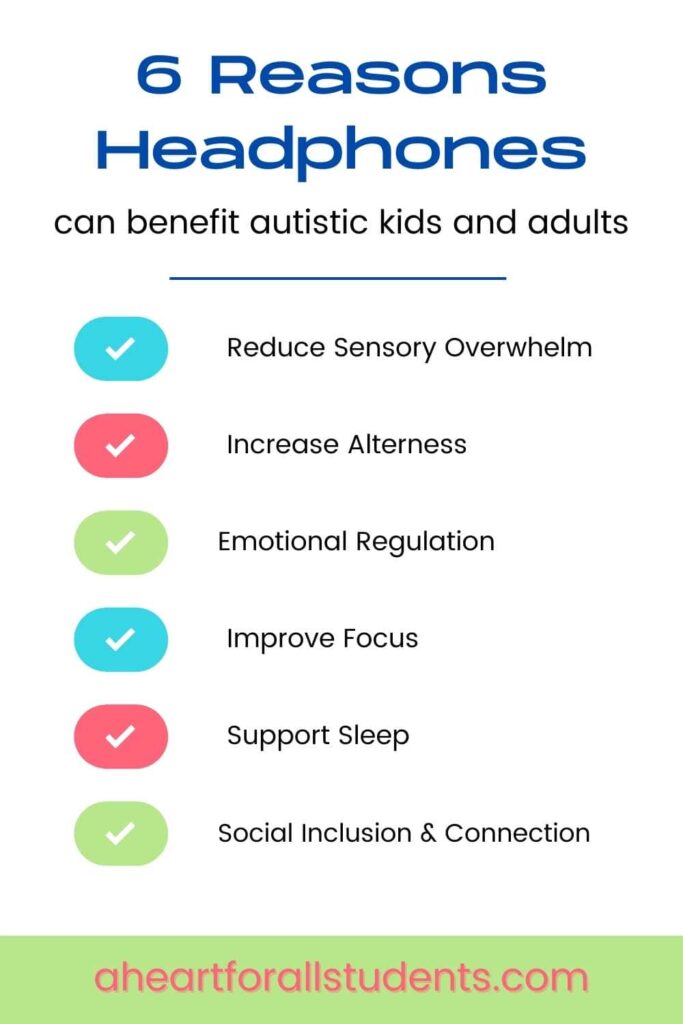Why do autistic people wear headphones? To better support autistic children, adults, and other sensory-sensitive people, let’s explore this topic. Specifically, why autistic people wear headphones and the benefits of doing so. Then later, we’ll dive into different types of headphones available.

7 Reasons Why Autistic People Wear Headphones
On any given weekend, shopping malls are filled with kids, teens, young adults, and older folks wearing headphones. Some wear them for fun, for fashion, or to enjoy their favorite tunes. However, many autistic people wear headphones out of necessity.

Here are seven reasons why autistic people wear headphones. We’ll discuss the benefits of wearing headphones for autistic children and adults. Later we’ll discuss a few style options to meet each auditory objective. You’ll soon see that what makes a good pair of headphones for one autistic person will be different than another.
1. Sensory Overwhelm
As we’ve noted, autistic individuals and others with sensory integration difficulties experience sensory overwhelm as part of their everyday lives.
While one’s sensory challenges can be related to any sensory system, some people have specific sound sensitivities. In other words, they have a lower threshold for incoming auditory input.
As such, they may wear headphones to reduce the intensity of auditory input to a more comfortable level.
Research shows that the use of headphones by autistic children results in a significant reduction in the fight-or-flight response. In the end, this allows them to function better throughout life.
2. Increase Alertness Levels
Another reason someone may wear headphones is to strategically use music as a way to increase alertness.
Studies have found a clear increase in mental and physical energy in relation to music. This is why you run or work out harder and longer when you’re listening to your favorite heart-pumping music.
An autistic or ADHD student who needs to increase alertness may benefit from listening to music. Upbeat music can support increased dopamine and thus improve motivation, drive, and focus. Again, this is a fantastic self-regulation strategy that anyone can use.

Related Post:
3. Emotional Regulation
Another reason a neurodivergent person may use headphones is to calm down after a stressful experience.
Using noise-canceling headphones to block out noise or to play calming music are both smart emotional-regulation reasons. Doing so reduces one’s sensory load which is an excellent stress reliever.
4. Support Focus
Another reason autistic people wear headphones is to improve their focus for learning.
Whether you homeschool or your child is in public school, reducing auditory distractions can make a huge difference for students. This is especially important if your child has an auditory processing disorder diagnosis.
5. Support Sleep
Another reason parents may get their children some type of noise-blocking headphones or ear muff is to support sleep.
Autistic and ADHD children and adults often struggle with sleep disorders. Using the right noise-blocking tool can be the answer to a good night’s sleep.
6. Social Inclusion in Celebrations and Other Events
The right headphones allow autistic individuals to partake in louder celebrations and other environments they normally wouldn’t be able to tolerate.
This makes headphones the perfect choice of accommodation to support inclusion, social skills and connection.
7. Improve Comprehension
Autistic children and adults often struggle with auditory processing of language. Some, having seen a specialized audiologist, will get a full auditory processing disorder diagnosis.
Others may struggle with dyslexia and other language-based learning challenges. If your neurodivergent student has problems with reading comprehension, consider using headphones for audiobooks.
Audiobooks are a powerful learning accommodation that removes barriers to learning. Regardless of diagnosis, young autistic people can wear headphones to listen to audiobooks of literature and textbooks. In the end, this accommodation can be an academic game changer.
Types of Noise-Canceling Headphones
Fortunately, there are several different types of headphones that can support autistic people. (Or anyone struggling with noise overwhelm.) Noise-attenuating headphones come in a variety of styles. Each pair of headphones can be different based on a number of variables.
- Sensory needs of the wearer
- Level of hearing protection needed (noise reduction rating)
- Intensity of auditory stimuli in the environment
- Sound quality is needed for entertainment
- Style preference
- Your child’s willingness to wear headphones
Fortunately, there’s no shortage of headphone options. This is perfect because as mentioned earlier, the best headphones for one person will be different than for another.
Headphones for Autistic Children
Fortunately, autistic kids have a variety of headphone options designed specifically to fit their unique needs and comfort.
For example, these noise reduction earmuffs have ear cups with super soft padding are are made to fit a child’s ears. A couple of other child-friendly headphone options include:
If your child has sensory aversions to headphones over their head, kids’ headband headphones are a great option. Both have an adjustable headband to meet your child’s comfort. Additionally, they’re a comfortable option to block outside noise while sleeping.

Noise-Reducing Options for Work and School
Noise cancelling ear plugs support focus, attention, and learning for work and school come in a variety of noise filtering levels. There are great options for people who need to engage in everyday activities but need to decrease the intensity of extraneous auditory information.
For example, say your child needs to focus on their school work, whether in homeschool or traditional school. You’d want to choose an option that allows them to hear, but at a lower volume. Some favorites are:
Additionally, they’re less invasive and less conspicuous.
Noise Blocking Ear Defenders
For full sound protection, an inexpensive pair of ear defenders is a wonderful idea.
- 3-M Kids Hearing Protection Ear Defenders
- Ear Defenders (Best Value Adults and Older Children)
Both pairs of headphones have a high level of noise-blocking protection to allow autistic kids and adults to enjoy the 4th of July fireworks.
Headphones with Good Sound Quality
There are many types of headphones that offer both noise reduction and sound quality. In my home, we’ve got several reasonably priced comfortable headphones with excellent sound quality.
Even without music, earbuds do a great job reducing auditory input so I can focus on my work. Learn more in 17 Top Noise-Cancelling Headphones.
How Do Noise-Canceling Headphones Work?
Noise canceling headphones reduce external noise while allowing the user to hear well enough to engage in regular activities.
There are two different types of noise canceling headphones.
One type uses active noise cancellation technology made with tiny microphones and sends out frequencies and white noise to offset incoming sound frequencies. In the end, this…
- Reduces the intensity of loud sounds and to
- Filters out subtle background noise
The other type of noise-canceling headphones, passive noise isolation, blocks sound in a different way. Specifically, they reduce sound through structural design intended to block out noise.
Autistic Traits and Sensory Experiences
One common trait of autism is unique and powerful sensory experiences. This means that an autistic nervous system receives and processes sensory information in a way that differs from those of non-autistic people.
For example, for those with auditory sensitivities, it means they have a hard time with loud noises. At times, even subtle ambient noise from the environment can lead to sensory overwhelm and distress. When referring to sensory overwhelm, we’re talking about when sensory input exceeds the regulation capacity of the brain.
Sensory Issues Aren’t Just an Autistic Thing
Often, people think that sensory issues are just an autistic thing. Or a sensory processing disorder thing. While it’s true that autistic individuals often struggle with significant symptoms of sensory processing dysfunction, they’re not the only ones impacted by their sensory needs.
In truth, we all have sensory needs because we all have eight sensory systems. As such, all humans function by taking in sensory inputs, processing them, and then responding to them. Let’s look at an example of sensory processing happening right now.
A Sensory Experience in This Moment
As you’re reading this article, your brain receives and processes the text on the screen. In other words, it’s processing the visual input while trying to make meaning from it.
If you can make meaning of the text, your brain is able to regulate the amount of incoming sensory input.
On the other hand, maybe you’re struggling to focus because your kids are fighting in the next room. The sound from their bickering is a form of sensory (auditory) input. On top of that, your back is throbbing (tactile input) from working outside all day.

When It’s Too Much
Under these circumstances, your brain may experience sensory overload if all these sensory inputs are too much at one time. In order to focus on this article, your brain needs to filter out:
- tactile input of the throbbing back,
- auditory input of your kids bickering,
- and process the visual input from the words you’re trying to read
This is a lot of work for the brain. And don’t forget about the brightness level on your device. What if the brightness level on the screen is causing you visual stress? That may put you over the edge.
Reducing Sensory Input
If the brightness on your device is too intense, you may feel distressed in your eyes. In response, you’d likely go into the device settings and dim the brightness level to your comfort.
After you’ve adjusted the intensity of the visual input on your device, you’re better equipped to continue reading.
However, what if someone told you that you should be reading from a brighter screen? I’m assuming you’d tell them to take the proverbial hike. Why?
Because we’re all individuals with varying needs. What someone else deems the “correct” brightness level for them is not going to be the same for you. This is what autistic and other neurodivergent people often experience in their daily lives.
Three Types of Sound Sensitivities
Now, not all autistic people struggle with sensory challenges related to auditory stimuli. And for those that do, they may have different types of noise sensitivities. Because in truth, there are three types of noise sensitivities that can impact an autistic person’s life.
- Misophonia
- Hyperacusis
- Photophobia
Let’s touch on each one now.
1. Misophonia
Misophonia is a sound sensitivity that’s triggered by subtle repetitive noises. Further, it can cause a person extreme emotional distress.
What makes this more complex is that it’s not unusual for the distressing sounds to be caused by a family member. Often when children have trouble with misophonia, it looks like behavioral issues. This is what happened with Sadie.
Noise and Behavior
Sadie, a 5-year-old autistic girl, was getting in trouble for her angry outbursts. Apparently, her older sister’s throat-clearing habit is the source of her daily distress. One morning, Mom hears her youngest screaming at the top of her lungs.
Stop making that noise!
When Mom runs into the family room, she notices her oldest child sitting on the couch nowhere near her little sister. In fact, her youngest is sitting at the kitchen table with her hands over her ears. Mom and Big sister are confused and frustrated.
An Occupational Therapy Evaluation Helps Parents
Clearly, the only possible explanation for Little Sister’s overreactions is that it’s “behavioral”, right? Not so fast.
Eventually, Mom digs deeper, taking a look at Sadie’s recent occupational therapy evaluation. The occupational therapist noted that Sadie struggles with sensory processing dysfunction.
Suddenly, it clicks for Mom. She does some research, learns about misophonia, and realizes her youngest child is struggling with intense auditory sensitivity. What looks like a behavioral response is a result of complete overwhelm. Her daughter needs support.
2. Hyperacusis
Two other forms of sound sensitivity are hyperacusis and phonophobia. Hyperacusis is sensitivity to loud noises that cause physical pain.
3. Phonophobia
The last type of sound sensitivity is referred to as phonophobia. This results in a person having intense anxiety and fear of entering into a noisy place. For any sound sensitivity, noise-canceling headphones are a fantastic option.
Recap: Why Do Autistic People Wear Headphones?
Autistic people wear headphones for a number of reasons. Noise sensitivity is more common in neurodivergent people. However, we all can become overwhelmed by too much noise at different times and seasons.
Understanding our own sensory needs whether noise-related or not, can help us better relate to and show compassion to the autistic community.
In the end, noise cancelling headphones are a useful tool to minimize the impact of outside noises that can cause distraction and distress. Noise reduction headphones can reduce noise levels to allow an autistic person to function at a more optimal level.
So, friend. Why does your autistic loved one wear noise-canceling headphones?

About the Author:
Lindsay is a trauma-informed educator with a Master’s Degree in Teaching. Her mission is to support moms to equip neurodivergent kids (ADHD, Autism, Dyslexia, Anxiety) to thrive as exactly who they’ve been created to be. Wait until you hear the story that led to it all…



